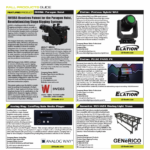As pixel mapping is becoming more and more commonplace in the lighting world, and LEDs are being incorporated into 3D configurations to create scenic objects like chandeliers and cubes, the challenge of programming them increases. Instead of looking at the pixels in a 2D flat “plan” view, now we’re beginning to think about looking at pixels from all sides and angles.
This new approach to pixel mapping has resulted in applications being forced to account for depth in the pixel map as well as width and height. But laying out a pixel map in 3D space is not easily achieved in most 2D-based media servers that have pixel mapping capabilities. And this is why some programmers turn to applications like Madrix because of the simplicity of creating a 3D pixel map.
Regardless of what software you use for pixel mapping in 3D, it’s really just a matter of accounting for the “Z” information (as in, X, Y and Z) and placing the pixels you want at the right depth. Here’s a quick breakdown of a couple of examples. and because of its wonderful 3D pixel mapping tools, I’m using Madrix as my software of choice for this demonstration.

Start with a Cube
Let’s begin with a cube, as this is probably the easiest 3D object to grasp and layout in 3D space. For this example, I’ve created a cube of five pixels wide by five pixels tall by five pixels deep. (See Fig. 1A). As you can see in this image, the cube of pixels looks like you might expect, and you can easily see how the pixels relate to each other in space.
Figure 1B, however is the 2D representation of the pixels in this same cube. (See Fig. 1B). It doesn’t really say much, does it?
In 2D view, it’s very hard to get any real idea of how that object and the video you want displayed on it will look in real space. The pixels are all there, and if you want to do a lot of brain games, you might be able to make sense of it. But ultimately, nothing beats having a 3D view of the pixels in real relationship to each other. And we have to see depth to achieve that.

Adding Depth
For the second example (which proved quite a bit tougher to create in 3D view, as I recently discovered), I’ve created a circle with the intention of creating a chandelier of LED pixel tubes. (You can see the chandelier from a variety of different angles in Fig. 2a, 2b, 2c).

This chandelier, as I drew it in Vectorworks, is comprised of three levels. The top level is a 10-foot (outer diameter) circle with 60 LT100 pixel tubes; the middle level is an eight-foot outer diameter circle with 48 LT100 pixel tubes; and the bottom level is a six-foot outer-diameter circle with 36 LT100 pixel tubes.

At first, I was stumped about how to lay this out in 3D space, so I opened up an Excel spreadsheet and created a 30×30 grid, since 30 pixels was the diameter of the largest circle (See Fig. 3). After a few minutes of trying to relate my grid to the real world, I opened my trusty MBox pixel mapper window and tried simply laying out some single pixel fixtures in 2D (See Fig. 4).


Back to Madrix
Once I looked at this, I thought it didn’t really give me a real representation of what the 3D chandelier was going to look like… so I went back to Madrix and started experimenting with single-pixel LEDs, using my Excel grid, and placing these LEDs into the Madrix window in the same locations as they were in my grid.

I started with the top ring of pixels, and gave them a “Z” of 1. Then I dropped in the next set of pixels with a “Z” value of 2, and began to position them inside the larger outer ring. As I experimented, I began to see the shape of a circular object taking place in the 3D view. (Fig. 5A and 5B).

Once I realized I was getting the hang of it, I then realized I could probably have done this even easier by simply creating a matrix in Madrix of 30x30x60 and simply deleting the pixels that weren’t needed for the circle (See Fig. 6). Live and learn, right?

A Bit Tedious — but Worth It
So the reason I’m sharing this journey here is to point out that creating a pixel map for a 3D object might be accomplished in a variety of ways, and it might not be as easy as laying out pixels in a 2D space. But ultimately, the end result is a 3D object that has depth and dimension, and when images are applied to these objects, they do more than simply flow left to right or top to bottom; they can also flow from the inside out or outside in as well, and that perspective is truly unique — well worth the time and effort to work out the best approach. (See Fig. 7).



